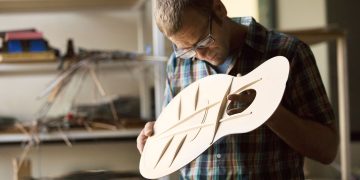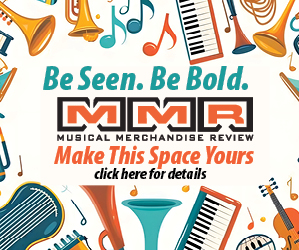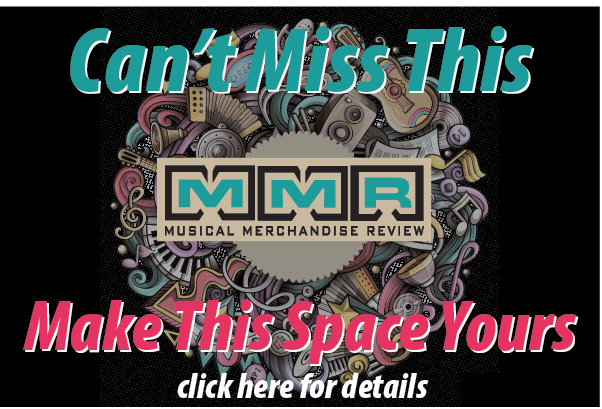 2022 marks the 75th anniversary of Milwaukee-based Hal Leonard, “The World’s Largest Source for Music Publications.” While much has changed at the company since brothers Harold (“Hal”)” and Everett Leonard Edstrom launched the business in 1947, in some ways it’s been a continuous thread with one consistent mission statement: producing impactful arrangements of music that can apply to musicians of all skill levels, and helping to expand the culture of music-making.
2022 marks the 75th anniversary of Milwaukee-based Hal Leonard, “The World’s Largest Source for Music Publications.” While much has changed at the company since brothers Harold (“Hal”)” and Everett Leonard Edstrom launched the business in 1947, in some ways it’s been a continuous thread with one consistent mission statement: producing impactful arrangements of music that can apply to musicians of all skill levels, and helping to expand the culture of music-making.
MMR recently sat down for a chat with Larry Morton, president and CEO, about Hal Leonard’s rich history and significant milestones throughout the organization’s evolution, its current efforts and achievements to support music scholarship and performance, and hopes for the future.
The early Hal Leonard publishing company had its roots in Harold Edstrom’s and Roger Busdicker’s involvement in both music education and their background in professional music performance. Can you talk about how this unique alchemy of skills helped set the foundation for Hal Leonard to connect with a broad swath of end-users?
Our founders started their careers as touring professional musicians and then transitioned to becoming music educators and music retailers. That background created two fundamental principles that still guide Hal Leonard 75 years later: First, we are fanatical about making great arrangements of music, so that it can be played by any musician at any level, while keeping the musical integrity of the song. Second, we are always exploring new ways to make it easier for people to start playing music through new learning techniques, a variety of approaches to music notation, and the integration of technology to assist with learning to play.
How important was – and is — the advocacy of, and partnership with, music education to the overall culture at Hal Leonard?
Being founded by music educators, and by having hundreds of music teachers working at the company, we believe music education is core to our DNA as a company. We are actively involved in every music education association, we support hundreds of events annually and we are tireless advocates of promoting the importance of music education to society as a whole.
How about some vital statistics from those early days: Where was the first company HQ? How big was it? How many employees were on board to begin with?
Our company was founded in 1947 in Winona, Minnesota, the home of our founders. It turned out to be serendipity because it’s a great location for centralized distribution in North America. From a humble store front with a few employees, our Winona campus now has over 300,000 square feet and 400 employees spread access two large distribution and printing facilities. In addition, we have our company HQ in Milwaukee, WI, along with US offices in Boston, Austin and San Francisco. For Europe, we have distribution centers in England and the Netherlands, along with offices in London, Berlin, Milan, and France. We have over 800 employees worldwide.
When considering the beginning stages of the company, what were some milestone folios that really helped establish Hal Leonard as a music publishing force to be reckoned with?
In the late 1940s/early ‘50s, the famous Pointer System course was a huge part of the company’s early success. Millions of copies were sold via retailers but also with custom-branded courses tied to big organ manufacturers of the day. The company also became a specialized publisher of school music arrangements for band, orchestras and choirs, which created a whole new industry segment. Another huge success in the early days was the E-Z Play Today series, which introduced a whole new music notation with note names inside larger note heads, simple right-hand arrangements and chord symbols. It remains one of the biggest selling songbook series of all time.
Learning Unlimited was a pioneer in print/audio instructional packages. Can you discuss the catalyst behind that division of Hal Leonard being launched and its subsequent growth?
Beginning in 1970, longtime HL president and CEO, Keith Mardak, along with two partners, created a new joint-venture in Milwaukee with the founders of Hal Leonard, called Learning Unlimited. They pioneered the use of audio recordings to demonstrate and play-along with publications, amongst many other new publications. Keith and his partners brought new energy to Hal Leonard and really shook up the industry. This constant innovation led to Hal Leonard expanding many different types of musical arrangement formats which in turn created more music makers in the market. Eventually, the Learning Unlimited venture was folded into Hal Leonard, and Keith was appointed general manager of the whole company. From then on, under Keith’s leadership, Milwaukee became more and more of the driving force for the company.
Mardak led the team who purchased Hal Leonard from the company’s founders. Can you describe the events leading up to that transition?
In 1981, Chappell Music (prior to becoming Warner-Chappell) acquired a 50 percent stake in Hal Leonard. A few years later, Chappell Music was being sold and in 1985, it created an opportunity for Keith to lead a buy-out of Chappell and the founders of Hal Leonard. It was a bold move, but anyone who knows Keith will not be surprised that he made it happen. Keith raised the money and gave a number of senior executives at the company the opportunity to invest in the company and become shareholders. As they say, the rest is history. Keith led the company through unprecedented growth that changed not only Hal Leonard, but the entire print music publishing industry. It was a great team, but it never would have happened without Keith. His drive, creativity, intensity, ambition and leadership are unparalleled in our industry. I joined the company in 1990, just five years after the buy-out, but Keith had already turned Hal Leonard into a global powerhouse. I would also add that Keith had the unique ability to lead, but also to groom others to be better leaders themselves. We all greatly benefited from his mentorship, especially me.
Since that time, through to the present day, Hal Leonard has acquired a number of other print music publishers – including some former major competitors – and entered into distribution partnerships with many others. How important has the process of bringing these other brands “under the Hal Leonard umbrella” been to the company’s evolution?
It is very important and it all starts with our “partnership” mentality. We’ve developed mutual admiration and trust with many companies over the years, and that sometimes leads to opportunities to work together in distribution deals, joint-ventures, or new publishing collaboration. Often, our acquisitions will naturally evolve from these associations after we have worked together for some years and built good relationships. We always think in terms of how we can make “1+1=3.” We think in terms of each party bringing something unique to the partnership that can make us better together than we are individually.
Hal Leonard has often been one step ahead of the pack when it comes to technology: cloud-based, digital, streaming, and so on. How has the company been able to anticipate and in some cases define these paradigm-altering advancements so consistently and successfully?
The key for us is keeping ourselves as close as possible to real, everyday musicians, teachers, students, hobbyists, weekend warriors, et cetera… The end users will always tell you what they are doing, so you just have to listen to them. Our staff is largely made up of passionate music makers, so we all live our work and we work to live… in music. The other big element for us is a willingness to “be our own spoilers” and be brave enough to disrupt your own business and the market around you. We have launched many innovative programs that have been harmful to other areas of our own business, but you have to do keep moving forward. My Dad used to say, “You can stand in the river with your arms out or you can swim. The river is going to keep moving whether you want it to or not.” So, we keep looking ahead and making changes to what we think the market wants or needs.
In the past decade or so, Hal Leonard has also expanded its reach beyond print music, rapidly growing as a distributor of a number of MI brands: Line 6, Innovative Percussion, Vertex, Hotone, and others. What was the behind the decision to enter into this new arena?
Because of our core music publishing business, we have contacts and distribution to every kind of retailer in the world that sells music products, whether they are a brick and mortar store or e-commerce. By touching all these thousands of retailers, we realized that we are in a unique position to sell more than just our own physical publications. This is especially important in that we sell to every kind of music retailer (piano, guitar, drums, et cetera) and we are a huge supplier outside the music channels as well. This broad, multi-channel distribution gave us the opportunity to take on MI products for distribution, first in music software and home recording, but then it expanded to live sound/pro audio, drums and drum hardware, guitars and pedals/effects, and many other categories, including accessories. We recently started new agreements with Pioneer and Chauvet to address the growing DJ market. We think we’re just scratching the surface of what our MI Products Distribution business can become. From a retailer point of view, we are their “easy button” in many ways. They already buy from Hal Leonard and we have the best service and staff in the industry, so it is much easier to use us a one-stop for the many MI lines that we sell.
In 2019, you succeeded Keith Mardak as company president and CEO. How much has that change represented a “sea change” for the company or those that do business with Hal Leonard, or to what extent has it been more a traditional “changing of the guard” with the longstanding mission statement and goals of the company remaining the same?
It has been a long-planned transition that started when I became president in 1999. Having been groomed by Keith for many years, the transition has been natural and more traditional. That said, the market has greatly changed since COVID, so we have adapted and changed many aspects of our business to pursue opportunities not only in the U.S., but around the world. Our mission of creating more music makers has remained the same, but our strategy has evolved quickly with the fast-paced market of the past few years.
Expectations and/or plans for the coming months and years for both Hal Leonard and the MI industry, as a whole?
The 2020 at-home explosion of new music makers is a big opportunity for Hal Leonard and for the industry as a whole. We have a once-in-a-generation chance to connect with these first-time music makers and help them get better at playing. We need them to learn to play and not give up since attrition has always been the biggest challenge for our industry. You will be seeing Hal Leonard continue to launch new learning programs, both physical and digital, to capitalize on this huge pool of potential life-long customers. We are intensely focused on capturing these budding rock stars and getting them hooked on music for life!




























